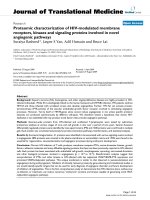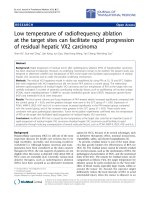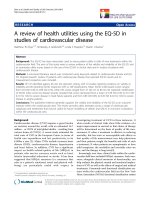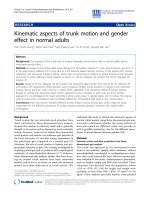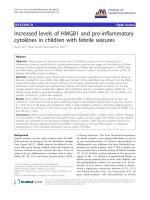Báo cáo hóa học: " Chemical characterization of extra layers at the interfaces in MOCVD InGaP/GaAs junctions by electron beam methods" ppt
Bạn đang xem bản rút gọn của tài liệu. Xem và tải ngay bản đầy đủ của tài liệu tại đây (570.23 KB, 7 trang )
NANO EXPRESS Open Access
Chemical characterization of extra layers at the
interfaces in MOCVD InGaP/GaAs junctions by
electron beam methods
Cesare Frigeri
1*
, Alexey Aleksandrovich Shakhmin
2
, Dmitry Anatolievich Vinokurov
2
,
Maria Vladimirovna Zamoryanskaya
2
Abstract
Electron beam methods, such as cathodoluminescence (CL) that is based on an electron-probe microanalyser, and
(200) dark field and high angle annular dark field (HAADF) in a scanning transmission electron microscope, are
used to study the deterioration of interfaces in InGaP/GaAs system with the GaAs QW on top of InGaP. A CL
emission peak different from that of the QW was detected. By using HAADF, it is found that the GaAs QW does
not exist any longer, being replaced by extra interlayer(s) that are different from GaAs and InGaP because of
atomic rearrangements at the interface. The nature and composition of the interlayer(s) are determined by HAADF.
Such changes of the nominal GaAs QW can account for the emission observed by CL.
Introduction
Several devices, such as HBTs, HEMTs, solar cells and
LEDs, are currently based on InGaP/GaAs heterojunc-
tion because of its superior properties with respect to
AlGaAs [1-4]. The InGaP/GaAs system, especially if it is
grown by metal organic vapour phase deposition
(MOCVD), has, however, the drawback that the inter-
faces between InGaP and GaAs are deteriorated, as
shown by photoluminescence, X-ray diffraction and
transmission electron microscopy (TEM), because there
is no common group V element across the interface [5].
This mostly affects the inverted GaAs-on-InGaP inter-
face where an unwanted extra interlayer forms, which
recombines the minority carriers more efficiently than
the GaAs quantum well [5-10]. The normal InGaP-on-
GaAs interface is always good, but this is not sufficient
to guarantee reliable device performance. The deteriora-
tion of the inverted GaAs-on-InGaP interface has been
seen to occur in practically every MOCVD InGaP/GaAs
heterostructure containing such an interface, to a more
or less great extent depending on the growth conditions
[5-10]. It could sometimes be avoided by the use of
growth interruption between the layers [6], the growth
on top of I nGaP of a thin ( 1 nm) intentional interfacial
layer of GaP [5,7,9] or GaAlAs [8], or the application of
a preflow of trimethylgallium on the In GaP surface
before switching on the AsH
3
flow [11].
A recent contribution to this field was based on catho-
doluminescence (CL) measurements [12,13]. The differ-
ence between the two interfaces was confirmed by
comparing two InGaP/GaAs systems containing a GaAs
QW and either one of the two interfaces [12,13]. One
sample had the layer sequence GaAs substrate/GaAs
buffer/AlGaAs/GaAs/InGaP with the normal interface.
It showed the expected GaAs QW emission (1.56 eV at
77 K). The other sample had the sequence GaAs sub-
strate/GaAs buffer/InGaP/GaAs/AlGaAs with the
inverted GaAs-on-InGaP interface. This sample did not
exhibit the expected QW emission. On the contrary, a
CL peak was seen at 1.48 eV, whi ch suggested that the
GaAs QW was absent, having been replaced by a transi-
tion layer of InGaAsP with mixed composition [12,13].
The aim of this study is to check by TEM whether the
CL results can be related to structural modifications of
theGaAsQW,suchasthepresenceofaninterlayerof
the type d escrib ed earlier. An a dditi onal objective is to
determine the composition of any extra layer that could
have been formed by using the innovative chemically
sensitive high angle annular dark field (HAADF) method
* Correspondence:
1
CNR-IMEM Institute, Parco Area delle Scienze 37/A, 43010 Parma, Italy
Full list of author information is available at the end of the article
Frigeri et al. Nanoscale Research Letters 2011, 6:194
/>© 2011 Frigeri et al; licensee Springer. This is an Open Access article distributed under the terms of the Creative Commons Attribution
License (http://creativecommons .org/license s/by/2.0), which permits unrestricted use, distr ibution, and reproduction in any medium,
provided the original work is properly cited.
in a scanning TEM thanks to its square dependence on
the atomic number.
Experiment
The InGaP/GaAs structures were g rown by MOCVD at
973 K using an Emcore GS3100 reactor, and they had the
following layer sequence: (100) GaAs substrate/GaAs
buffer (180 nm)/InGaP (130 nm)/GaAs QW (10 nm)/
AlGaAs (370 nm) cap. The expected layer thickness is
given in brackets. Both CL and TEM gave 160 nm for
InGaP, 360 nm for AlGaAs and 10 ± 1 nm for QW. They
were analysed by spectroscopic CL and TEM. CL wa s
done at temperatures of 300 and 77 K in an electron-
probe microanalyser Camebax supplied with the CL sys-
tem. TEM observations were done in an FEG 2200FS
JEOL instrument on <011> cross-sectional specimens
prepared by the standard sandwich procedure and finally
thinned with Ar ion bombardment. The (200) dark field
(DF) mode and the HAADF method in association with
the scanning operation of the TEM (STEM) were used
for detection of interface modifications and composition.
Results and discussion
Different electron beam energies were used to check the
in-depth distribution of the layers. In the CL spectra at
77 K, bands corresponding to AlGaAs layer at 1.89 eV
and InGaP layer at 1.94 eV were detected at th e expected
depth, indicating a composition of Al
0.26
Ga
0.74
As and
In
0.51
Ga
0.49
P, respectively [12,13]. However, the emission
from the G aAs QW was n ot detected; only a wide lumi-
nescence band at 1.48 eV, which could rather correspond
to bulk GaAs, was observed as shown in the CL spectrum
in the near-infrared (IR) region of Figure 1, where the CL
emission A of the sample studied here is compared with
thepeakBoftheGaAsQW(1.56eVat77K)observed
in a similar structure but containing the normal InGaP-
on-GaAs interface , i.e. GaAs substrate/GaAs buffer/
AlGaAs/GaAs/InGaP [12,13].
To check the reason for such anomalous emission,
TEM (200) DF and STEM-HAADF were applied.
Figure 2 shows the (200) DF TEM image of the sample.
The nominal GaAs QW layer is the dark stripe between
InGaP and AlGaAs. It exhibits a contrast darker than
the GaAs substrate/buffer as seen in Figure 2b. This
suggests that this layer is not GaAs. Figure 2c shows the
high-magnification image of the nominal QW showing
two different contrasts inside it in agreement with the
profile of Figure 2b, confirming that the nominal QW is
made up of two sublayers, as could also be concluded
from Figure 2b. As t he images were acquired in thin
areas of the TEM specimen, the ki nematical approxima-
tion is used, according to which the (200) DF intensity
I
200
is proportional to
F
200
2
,withF
200
as the s tructure
factor of the (200) diffraction that depends on the
atomic scattering factors f of the elements in the III-V
compound as it is F
200
=4(f
III
- f
V
) [14-16]. To evaluate
composition, the DF contrast function C
200
,whichis
defined as the ratio betwe en the (200) DF intensity dif-
fracted by a given layer of general form A
x
B
1-x
C
y
D
1-y
and that diffracted by GaAs, is used. An alloy looks dar-
ker than GaAs when C
200
is <1. C
200
depends on the
square of the composition as does
F
200
2
[14-16] because
f
III
and f
V
have to be introduced in proportion to the
relative composition of the element they refer to.
Computed plots of C
200
for In
x
Ga
1-x
As and GaAs
1-y
P
y
are given in Figure 3. These plots show that these two
alloys look darker than GaAs for x <0.437andy <
0.707, respectively. In
x
Ga
1-x
As
1-y
P
y
is also darker than
GaAs for x <0.437andy < 0.707 as is seen by similar
plots; by way of examp le, only the plot for In
x
Ga
1-x
As
1-
y
P
y
with x = 0.1 is shown in Figure 3. No other alloy
has C
200
< 1. Though (200) DF can clearly tell which
alloy had formed in place of the nominal G aAs QW at
the inverted GaAs-on-InGaP interface, no exact estima-
tion of the composition is straightforward because of
thesquaredependenceofC
200
on the composition and
the indication of just a composition range.
To evaluate better the composition, the STEM-HAADF
method was used. The STEM-HAAD F image of the
wholestructureisgiveninFigure4a.Theintensitypro-
file of Figure 4b shows that the contrast at the nominal
GaAs layer is different from that of the GaAs substrate,
confirming the DF results that the nominal QW is no
longer made of GaAs. It also shows that the nominal
GaAs well is made up o f two sublayers, 1 and 2, with
appreciable difference in HAADF contrast (Figure 4b,c);
sublayer 1 (4 nm t hick), which is closer to the GaAs-on-
InGaP interface, with a contrast higher than the GaAs
Figure 1 CL spec trum A in the ne ar-IR reg ion of th e
investigated sample compared with that (B) of a sample
exhibiting the expected GaAs QW emission. CL at 77 K with 5
keV beam energy.
Frigeri et al. Nanoscale Research Letters 2011, 6:194
/>Page 2 of 7
substrate, and sublayer 2 (6 nm thick), which is on the
side of the AlGaAs barrier, with a lower contrast.
The HAADF image is formed by colle cting the inco-
herently scattered electrons at high angles [17,18]. Single
atoms scatter incoherently, and the image intensity is
the sum of the individual atomic scattering contribu-
tions [19]. The higher the atomic number Z,thelarger
the scattering angle is. The H AADF intensity turns out
to be proportional to Z
n,
with n = 2 [17,18,20], so that a
more direct evaluation of the c omposition is possible.
Such dependence could also take other values for the
exponent n,i.e.1.7<n < 2 [20]. Here it is assumed that
n = 2. This choice stems from the fact that only the
exponent 2 can fully account for our experimental ratios
of the intensities of every couple of layers of known
composition in the structures (GaAs substrate/buffer,
In
0.51
Ga
0.49
P, Al
0.26
Ga
0.74
As, taken as two by two) as
shown in Figure 5, where the calculated HAADF
QW
Figure 2 (a) (200) DF TEM image of the sample and (b) intensity profile across it al ong the negative growth direction.In(a),the
nominal GaAs QW is the dark stripe between InGaP and AlGaAs and corresponds to the downward peak between InGaP and AlGaAs in (b). The
profile (b) clearly shows that it exhibits a contrast darker than the GaAs substrate/buffer (at the right-hand side). (c) High-magnification (200) DF
image of the GaAs QW. The image has been treated with Adobe Photoshop to improve the visibility of the extra layer in proximity of the GaAs-
on-InGaP interface.
0
1
2
3
4
5
0 0,2 0,4 0,6 0,8 1 1,2
x, y
(
200
)
DF contrast
C
200
In
x
Ga
1-x
As
GaAs
1-y
P
y
In
0.1
Ga
0.9
As
1-y
P
y
Figure 3 Calculated (200) DF contrast function C
200
for In
x
Ga
1-
x
As (dash and dot line), GaAs
1-y
P
y
(solid line) and In
x
Ga
1-x
As
1-
y
P
y
with x = 0.1 (dash line) (see text).
Frigeri et al. Nanoscale Research Letters 2011, 6:194
/>Page 3 of 7
intensity ratios for the two extreme cases of n = 1.7 and
n = 2 are compared with the experimental ratios. The
best agreement between the calculated rations and those
of the experiment is obtained for n =2.
The composition of the nominal GaAs QW is deter-
mined from HAADF pictures by taking the known com-
positions of the other alloys (GaAs substrate/buffer,
In
0.51
Ga
0.49
P, Al
0.26
Ga
0.74
As) and related HAADF inten-
sity values as reference, i.e. as internal standards. The
ratios of the experime ntal intensity of subla yers 1 and 2
to the intensity of all the inner standards are then com-
pared to the calculated values of similar ratios for all the
all oys that can be formed by combining together all the
elements present at the inverted GaAs-on-InGaP inter-
face assuming the Z
2
dependence of the intensities . The
ratio R of the HAADF intensity of a generic sublayer
(subl) A
p
B
q
C
r
to the one of a generic standard (std)
E
k
F
m
G
n
is calculated from the equation:
R
IABC
IEFG
pZ qZ rZ
kZ m
pq r
km n
ABC
E
==
++
+
HAADF
subl
HAADF
std
()
()
222
2
ZZnZ
FG
22
+
(1)
c
)
b)
Q
W
Figure 4 (a) STEM-HAADF image of the whole structure. The nominal GaAs QW is the bright stripe between the InGaP and AlGaAs barriers.
(b,c) HAADF intensity profile across (a) and only across the nominal GaAs QW at higher magnification, respectively. Intensity scan along the
negative growth direction. In (c), 1 and 2 indicate the two sublayers replacing the nominal GaAs QW (see text).
0,88
0,9
0,92
0,94
0,96
0,98
1
1,02
1 2 3
HAADF Intensity Ratio
n=1.7
n = 2
Exp.
Al
0.26
Ga
0.74
As
vs
GaAs
In
0.51
Ga
0.49
P
vs
GaAs
Al
0.26
Ga
0.74
As
vs
In
0
.
5
1
Ga
0
.4
9
P
Figure 5 Choice of the exponent n. Calculated HAADF intensity
ratios between the three inner standards, taken two by two, for n =
1.7 (black dash and dot line, dark lozenges) and n = 2 (blue solid
line, blue circles) as compared to the relevant experimental ratios
(red solid line, red squares). Within experimental errors, exponent n
= 2 fits very well to the experiment.
Frigeri et al. Nanoscale Research Letters 2011, 6:194
/>Page 4 of 7
The alloy whose R matches the experimental ratio
R
exp
is the one that a sublayer is made of.
The experimental ratios R
exp
of the HAADF intensity
of sublayer 1 of the nominal GaAs layer to those of the
GaAs substrate, In
0.51
Ga
0.49
PandAl
0.26
Ga
0.74
As, are
R
exp
= 1.02, R
exp
=1.09andR
exp
= 1.12, respectively
(Table 1). For sublayer 2 of the nominal GaAs QW, the
same ratios are 0.97, 1.03 and 1.06, respectively
(Table 2). The compounds that exhibit ratio R of their
calculated intensitiestoGaAssubstrate,In
0.51
Ga
0.49
P
and Al
0.26
Ga
0.74
As, in the same range as the experime n-
tal values given above are only In
x
Ga
1-x
As, GaAs
1-y
P
y
and In
x
Ga
1-x
As
1-y
P
y
, which are in fairly good qualitative
agreement with (200) DF. The other alloys that may be
formed at the inverted interface yield (much) different
ratios for any possible composition.
Figure 6 is a worked-out example of the procedure used
to extract information on the nature and composition of
sublayers 1 and 2. Figure 6 is the plot of the calculated
intensity ratio between In
0.15
Ga
0.85
As
1-y
P
y
and GaAs.
It shows th at the experimental value o f R
exp
=1.02for
sublayer 1 can be accounted for if the layer is
In
0.15
Ga
0.85
As
0.81
P
0.19
. A similar plot for In
x
Ga
1-x
As to
GaAs shows that In
0.03
Ga
0.97
As also fits the experimental
result R
exp
= 1.02. The same procedure applied using the
In
0.51
Ga
0.49
PandAl
0.26
Ga
0.74
As laye rs as stan dards leads t o
the same results for the stoichiometric indices, within 5%.
By taking average v alues, it turns out that the sublayer 1
can be either In
0.15
Ga
0.85
As
0.80
P
0.20
or In
0.023
Ga
0.977
As. As
for subl ayer 2 of the nominal GaAs QW, i t results in either
In
0.05
Ga
0.95
As
0.84
P
0.16
or GaAs
0.91
P
0.09
by the same
procedure.
The TEM results indicating the formation of InGaAsP
at the l ocation of the nominal GaAs QW are in qualita-
tive agreement with an a nalogous conclusion drawn by
CL in refs. [12,13], where a quaternary with the In com-
posit ion in the 0-0.15 range and the P one a little above
zero was propo sed. Both the TEM and CL results su g-
gest that at the inverted GaAs-on-InGaP interface there
is the formation of an extra quaternary layer of InGaAsP
inside the nominal GaAs QW (and partially replacing
it), as also suggested in several studies [5,6,8-10,16,21].
The formation of just InGaAs as sublayer 1 might be
less likely because it might easily happen that residual P
atoms, which remained in the reactor after the PH
3
flow
had been switched off, are incorporated in the first
monolayers of the GaAs QW, since Ga prefers to bond
to P rather than to As [22], as long as P atoms are avail-
able (P/As inte rmixing mechanism, see later). Moreover,
the absence of P in sublayer 1 would contradict its pre-
sence in sublayer 2. On the other hand, the sequence
inside the nominal GaAs QW such as layer 1 =
In
0.15
Ga
0.85
As
0.80
P
0.20
and layer 2 =
In
0.05
Ga
0.95
As
0.84
P
0.16
or GaAs
0.91
P
0.09
is congruent. In
fact , it matches the reasona ble expectation that [In] and
[P]decreasebymovingawayfromInGaP,i.e.bygoing
deeper into the nominal GaAs QW, while [Ga] and [As]
increase. The stoichiometry of the sublayers 1 and 2 as
determined by STEM-HAADF thus indicates a slight In
and P enrichment of the nominal GaAs QW, which
therefore changes its nature. Three mechanisms can
cause such In and P enrichment, namely, In segregation
in the growth direction, P/As exchange across the inter-
face and P/As intermixing in proximity of the inverted
interface, as discussed in other studies [5,6,8-10,16,21].
The three mechanisms are sketched in Figure 7. Indium
surface segregation has been shown for other In-con-
taining systems such as InGaAs/GaAs [23,24]. For the
InGaP/GaAs system, the action of In segregation has
been proven by experiments, showing that the growth of
a thin GaP layer on the top of InGaP, before GaAs is
grown, is effective in preventing the formation of the
quaternary interlayer because In segregates into the
interpos ed GaP layer and cannot reach the GaAs [5]. In
segregates into the growing GaAs layer as soon as the
latter starts to grow. In segregation is a kinetically dri-
ven process and depends strongly on the growth tem-
perature [5]. It may occur within the first few
monolayers of the layer grown next [5,23,24]. P/As
exchange across the interface should be excluded
Table 1 Values of the experimental ratio R
exp
of the HAADF intensity I
HAADF
of sublayer #1 to those of the three alloys
(GaAs substrate, In
0.51
Ga
0.49
P and Al
0.26
Ga
0.74
As) contained in the sample and used as standards
I
I
HAADF
HAADF
Subl
GaAs
(#)
()
1
I
I
HAADF
HAADF
Subl
In Ga P
(#)
()
1
051 049
I
I
HAADF
HAADF
Subl
Al Ga As
(#)
()
1
026 074
R
exp
1.02 1.09 1.12
Table 2 Values of the experimental ratio R
exp
of the HAADF intensity I
HAADF
of sublayer #2 to those of the three alloys
(GaAs substrate, In
0.51
Ga
0.49
P and Al
0.26
Ga
0.74
As) contained in the sample and used as standards
I
I
HAADF
HAADF
Subl
GaAs
(#)
()
2
I
I
HAADF
HAADF
Subl
In Ga P
(#)
()
2
051 049
I
I
HAADF
HAADF
Subl
Al Ga As
(#)
()
2
026 074
R
exp
0.97 1.03 1.06
Frigeri et al. Nanoscale Research Letters 2011, 6:194
/>Page 5 of 7
according to our results. In fact, this mechanism would
entail the incorporation of As in the bottom InGaP with
the formation of some InGaAsP alloy inside the nominal
InGaP layer, with the consequent broadening of the
interface towards both the nominal InGaP and GaAs
layers. These detailed investigations by chemically sensi-
tive methods in a TEM right of the inverted interface
do not confirm such symmetrical b roadening and allow
excluding the P/As exchange mechanism. The interface
broadening towards only the top GaAs layer was
observed by TEM also in other MOVPE-grown InGaP/
GaAs samples [16]. P/As intermixing occurs at the
beginningofGaAsgrowthafterthegrowthofInGaP
has finished. It consists in the fact that when the Ga
and As fluxes are switched on to grow GaAs, s ome of
the incoming Ga atoms bond to residual P atoms that
are still remaining in the MOCVD chamber in contact
with the sample surface after the PH
3
flux has been
switched off. This is because the chemical bond strength
of Ga-P is greater than that of Ga-As [22], which results
in As substitution by P [9,22]. S uch intermixing is lim-
ited to the first monolayers of the growing nominal
GaAs because the residual P atoms vanish out very
quickly as no PH
3
flux is active. As for In segregation,
P/As intermixing also depends on the substrate tem-
perature which affects, e.g., the diffusion length of the P,
As and Ga atoms on the growing surface. It also
depends on the gas fluxes, on the application or non-
application of a PH
3
-purging procedure or growth inter-
ruption [6]. Although the formation of an extra layer at
the inverted interface during growth has been reported
in a majority of the literature [5-10, 21 and references
therein], its composition was seen to vary depending on
the growth conditions used, as summarized above. In
fact, it has been seen by photoluminescence that the
emission associated with the extra layer spans quite a
wide range, i.e. from 862 to 914 nm [5-10,21]. A major-
ity of the published articles concluded that the extra
layer is InGaAsP albeit with different compositions. Our
results agree with this hypothesis. They also show that a
finer structure may exist in the modified nominal GaAs
QW, i.e. the presence of two sublayers: one more In-
and P-rich layer closer to the undergrown InGaP layer
and a s econd one that is less In and P rich farther from
it. This structure is certainly due to the expected reduc-
tion of P/As intermixing and In segregation as the dis-
tance from the inverted interface increases.
Conclusions
The deterioration of the structure of th e GaAs QW in an
InGaP/GaAs/AlGaAs heterostructure grown by MOCVD
has been studied by CL and (S)TEM. The chemically sen-
sitive (200) DF and HAADF methods of (S)TEM helped
us to establish that the nominal GaAs QW has changed
its structure, being replaced by two sublayers made of
InGaAsP with different compositions. The sublayer clo-
ser to the inverted GaAs-on-InGaP interface is more In
and P rich than the one on the side of the AlGaAs-on-
GaAs interface. The composition of the extra layer of
InGaAsP closer to the inverted GaAs-on-InGaP interface,
as determined by STEM-HAADF, reasonably accounts
for the anomalous emission measured by CL. The forma-
tion of the extra layers during growth was ascribed to the
rearrangement of the atoms available at the inverted
GaAs-on- InGaP interface caused by In segregat ion in the
growth direction and P/As intermixing during the early
stages of the GaAs QW growth.
0,6
0,7
0,8
0,9
1
1,1
1
,
2
0 0,2 0,4 0,6 0,8 1 1,
2
I(In
0.15
Ga
0.85
As
1-y
P
y
) / I(GaAs)
y
In
0.15
Ga
0.85
As
1-y
P
y
/GaAs
0,95
1
1,05
1,1
1,15
0 0,05 0,1 0,15 0,2 0,25
I(In
0.15
Ga
0.85
As
1-y
P
y
) / I(GaAs)
y
Figure 6 Plot of the calculated ratio R b etween the HAADF
intensities of In
0.15
Ga
0.85
As
1-y
P
y
and GaAs. Inset is the top left
part of the plot.
Figure 7 Sketch of the three possible mechanisms of atom
rearrangement at the inverted GaAs-on-InGaP interface. 1):
indium segregation in the growth direction, 2): P/As exchange
across the interface, and 3): P/As intermixing in the growing GaAs
QW (see text).
Frigeri et al. Nanoscale Research Letters 2011, 6:194
/>Page 6 of 7
Abbreviations
CL: cathodoluminescence; HAADF: high-angle annular dark field; MOCVD:
metal organic vapour phase deposition; STEM: scanning TEM; TEM:
transmission electron microscopy.
Author details
1
CNR-IMEM Institute, Parco Area delle Scienze 37/A, 43010 Parma, Italy
2
Ioffe
Physical Technical Institute, 194021 Polytekhnicheskaya 26, Saint-Petersburg,
Russia
Authors’ contributions
CF made substantial intellectual contributions to the study. Carried out the
TEM-HAADF, made the results interpretation and wrote the paper. AAS
performed the measurement and interpretation of the cathodoluminescence
results and revised the manuscript. DAV made the design and MOCVD
growth of the heterostructures. MVZ supervised the work, participated in
discussion of the results and in revising the manuscript.
Competing interests
The authors declare that they have no competing interests.
Received: 10 September 2010 Accepted: 3 March 2011
Published: 3 March 2011
References
1. Fu SI, Cheng SY, Lai PH, Tsai YY, Hung CW, Yen CH, Liu WC: ’A Study of
Composite-Passivation of an InGaP/GaAs Heterojunction Bipolar
Transistor’. J Electrochem Soc 2006, 153:G938.
2. Wang CK, Yu KH, Chiou WH, Chen CY, Chuang HM, Liu WC: ’On the high-
performance n
+
-GaAs/p
+
-InGaP/n-GaAs high-barrier gate camel-like
HFETs ‘. Solid State Electron 2003, 47:19.
3. Bosi M, Pelosi C: ’The Potential of III-V Semiconductors as Terrestrial
Photovoltaic Devices’. Prog Photovolt Res Appl 2007, 15:51.
4. Lee CL, Wu MC, Lin W: ’The influence of window layers on the
performance of 650 nm AlGaInP/GaInP multi-quantum-well light-
emitting diodes’. J Cryst Growth 1999, 200:382.
5. Zhang XB, Ryou JH, Dupuis RD, Walter G, Holonyak N Jr: ’Metalorganic
Chemical Vapor Deposition Growth and Characterization of InGaP/GaAs
Superlattices’. J Electron Mater 2006, 35:705.
6. Hsieh YC, Chang EY, Yeh SS, Chang CW, Luo GL, Chang CY, Lee CT:
’Optimization of the growth of the InGaP etch-stop layer by MOVPE for
InGaP/GaAs HBT device application’. J Cryst Growth 2006, 289:96.
7. Kúdela R, Kučera M, Olejníková B, Eliáš P, Hasenöhrl S, Novák J: ’Formation
of interfaces in InGaP/GaAs/InGaP quantum wells’. J Cryst Growth 2000,
212:21.
8. Tsai CY, Moser M, Geng C, Härle V, Forner T, Michler P, Hangleiter A,
Scholz F: ’Interface characteristics of InGaP/GaAs double heterostructures
grown by metalorganic vapor phase epitaxy’. J Cryst Growth 1994,
145:786.
9. Guimarães FEG, Elsner B, Westphalen R, Spangenberg B, Geelen HJ, Balk P:
’LP-MOVPE growth and optical characterization of GaInP/GaAs
heterostructures: interfaces, quantum wells and quantum wires’. J Cryst
Growth 1992, 124:199.
10. Kwon YH, Jeong WG, Cho YH, Choe BD: ’Effect of GaAs
y
P
1-y
(0≤y<1)
interlayers on the structural, optical, and electrical characteristics of
GaAs/InGaP heterojunction’. Appl Phys Lett 2000, 76:2379.
11. Nittono T, Sugitani S, Hyuga F: ’Photoluminescence characterization of
InGaP/GaAs heterostructures grown by metalorganic chemical vapor
deposition’. J Appl Phys 1995, 78:5387.
12. Shakhmin AA, Zamoryanskaya MV, Arsentyev IN, Konnikov SG,
Vinokurov DA, Stankevich AL, Tarasov IS: ’GaAs quantum well structures
investigation by local cathodoluminescence’. Superlatt Microstruct 2009,
45:376.
13. Konnikov SG, Gutkin AA, Zamoryanskaya MV, Popova TB, Sitnikova AA,
Shakhmin AA, Yagovkina MA: ’Integrated diagnostics of heterostructures
with QW layers’. Semiconductors 2009, 43:1240.
14. Bithell EG, Stobbs WM: ’Composition determination in the GaAs/(Al,Ga)As
system using contrast in dark-field transmission electron microscope
images’. Philos Mag A 1989, 60:39.
15. Petroff PM: ’Transmission electron microscopy of interfaces in III-V
compound semiconductors’. J Vac Sci Technol 1977, 14:973.
16. Frigeri C, Attolini G, Bosi M, Pelosi C, Germini F: ’Parasitic Interlayer at the
GaAs-on-InGaP Interface in MOVPE InGaP/GaAs: A Study by the
Chemically Sensitive (200) Diffraction’. J Electrochem Soc 2009, 156:H448.
17. Pennycook SJ, Berger SD, Culbertson RJ: ’Elemental Mapping with
Elastically Scattered Electrons’. J Microsc 1986, 144:229.
18. Pennycook SJ, Jesson DE: ’High-resolution Z-contrast imaging of crystals’.
Ultramicroscopy 1991, 37:14.
19. Williams DB, Carter CB: In Transmission Electron Microscopy. Volume 3. New
York: Springer; 1996, chap. 22.
20. Walther T: ’A new experimental procedure to quantify annular dark field
images in scanning transmission electron microscopy’.
J Microsc 2006,
221:137.
21. Sharma TK, Gokhale MR, Arora BM: ’Long-wavelength photoluminescence
from InGaP/GaAs heterointerfaces grown by metal organic vapour-
phase epitaxy’. J Cryst Growth 2000, 213:241.
22. Decolbert J, Patriarche G: ’Transmission electron microscopy study of the
InP/InGaAs and InGaAs/InP heterointerfaces grown by metalorganic
vapor-phase epitaxy’. J Appl Phys 2002, 92:5749.
23. Frigeri C, Di Paola A, Gambacorti N, Ritchie DM, Longo F, Giovanna MD:
’Transmission electron microscopy and X-ray diffraction investigation of
In segregation in MOVPE-grown InGaAs-based MQWs with either GaAs
or AlGaAs barriers’. Mater Sci Eng B 1994, 28:346.
24. Larive M, Nagle J, Landesman JP, Marcadet X, Mottet C, Bois P: ’In situ
core-level photoelectron spectroscopy study of indium segregation in
GaInAs/GaAs heterojunctions grown by molecular-beam epitaxy’. J Vac
Sci Technol B 1993, 11:1413.
doi:10.1186/1556-276X-6-194
Cite this article as: Frigeri et al.: Chemical characterization of extra
layers at the interfaces in MOCVD InGaP/GaAs junctions by electron
beam methods. Nanoscale Research Letters 2011 6:194.
Submit your manuscript to a
journal and benefi t from:
7 Convenient online submission
7 Rigorous peer review
7 Immediate publication on acceptance
7 Open access: articles freely available online
7 High visibility within the fi eld
7 Retaining the copyright to your article
Submit your next manuscript at 7 springeropen.com
Frigeri et al. Nanoscale Research Letters 2011, 6:194
/>Page 7 of 7
